最新GOOGLE搜索从入门到精通
- 格式:doc
- 大小:24.35 MB
- 文档页数:69
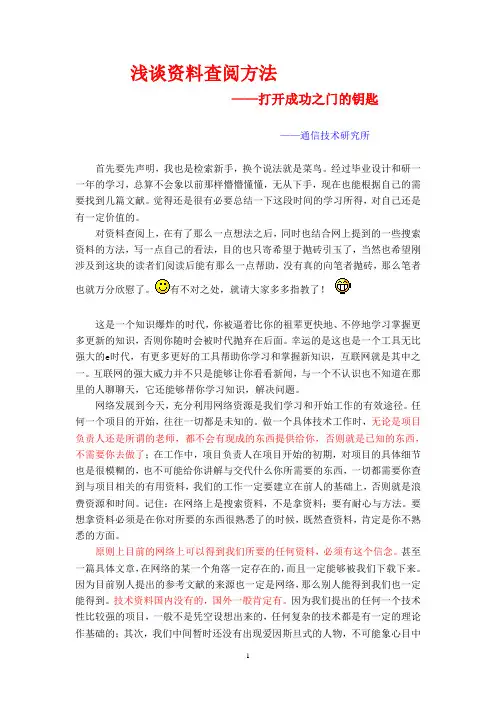
浅谈资料查阅方法——打开成功之门的钥匙——通信技术研究所首先要先声明,我也是检索新手,换个说法就是菜鸟。
经过毕业设计和研一一年的学习,总算不会象以前那样懵懵懂懂,无从下手,现在也能根据自己的需要找到几篇文献。
觉得还是很有必要总结一下这段时间的学习所得,对自己还是有一定价值的。
对资料查阅上,在有了那么一点想法之后,同时也结合网上提到的一些搜索资料的方法,写一点自己的看法,目的也只寄希望于抛砖引玉了,当然也希望刚涉及到这块的读者们阅读后能有那么一点帮助,没有真的向笔者抛砖,那么笔者也就万分欣慰了。
有不对之处,就请大家多多指教了!这是一个知识爆炸的时代,你被逼着比你的祖辈更快地、不停地学习掌握更多更新的知识,否则你随时会被时代抛弃在后面。
幸运的是这也是一个工具无比强大的e时代,有更多更好的工具帮助你学习和掌握新知识,互联网就是其中之一。
互联网的强大威力并不只是能够让你看看新闻,与一个不认识也不知道在那里的人聊聊天,它还能够帮你学习知识,解决问题。
网络发展到今天,充分利用网络资源是我们学习和开始工作的有效途径。
任何一个项目的开始,往往一切都是未知的。
做一个具体技术工作时,无论是项目负责人还是所谓的老师,都不会有现成的东西提供给你,否则就是已知的东西,不需要你去做了;在工作中,项目负责人在项目开始的初期,对项目的具体细节也是很模糊的,也不可能给你讲解与交代什么你所需要的东西,一切都需要你查到与项目相关的有用资料,我们的工作一定要建立在前人的基础上,否则就是浪费资源和时间。
记住:在网络上是搜索资料,不是拿资料;要有耐心与方法。
要想拿资料必须是在你对所要的东西很熟悉了的时候,既然查资料,肯定是你不熟悉的方面。
原则上目前的网络上可以得到我们所要的任何资料,必须有这个信念。
甚至一篇具体文章,在网络的某一个角落一定存在的,而且一定能够被我们下载下来。
因为目前别人提出的参考文献的来源也一定是网络,那么别人能得到我们也一定能得到。
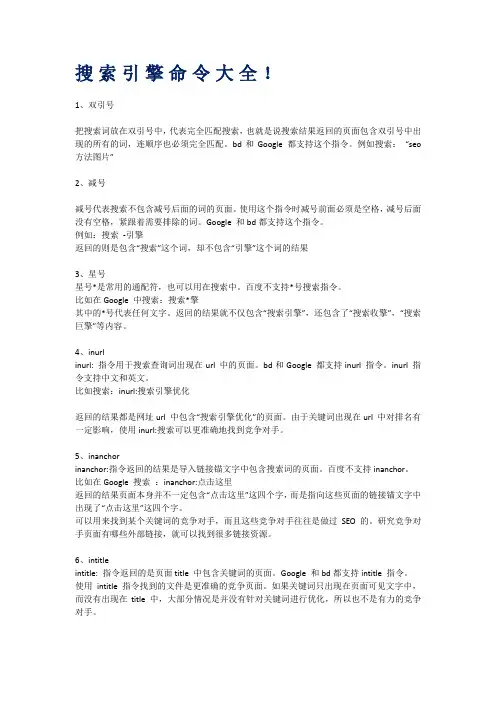
搜索引擎命令大全!1、双引号把搜索词放在双引号中,代表完全匹配搜索,也就是说搜索结果返回的页面包含双引号中出现的所有的词,连顺序也必须完全匹配。
bd和Google 都支持这个指令。
例如搜索:“seo 方法图片”2、减号减号代表搜索不包含减号后面的词的页面。
使用这个指令时减号前面必须是空格,减号后面没有空格,紧跟着需要排除的词。
Google 和bd都支持这个指令。
例如:搜索-引擎返回的则是包含“搜索”这个词,却不包含“引擎”这个词的结果3、星号星号*是常用的通配符,也可以用在搜索中。
百度不支持*号搜索指令。
比如在Google 中搜索:搜索*擎其中的*号代表任何文字。
返回的结果就不仅包含“搜索引擎”,还包含了“搜索收擎”,“搜索巨擎”等内容。
4、inurlinurl: 指令用于搜索查询词出现在url 中的页面。
bd和Google 都支持inurl 指令。
inurl 指令支持中文和英文。
比如搜索:inurl:搜索引擎优化返回的结果都是网址url 中包含“搜索引擎优化”的页面。
由于关键词出现在url 中对排名有一定影响,使用inurl:搜索可以更准确地找到竞争对手。
5、inanchorinanchor:指令返回的结果是导入链接锚文字中包含搜索词的页面。
百度不支持inanchor。
比如在Google 搜索:inanchor:点击这里返回的结果页面本身并不一定包含“点击这里”这四个字,而是指向这些页面的链接锚文字中出现了“点击这里”这四个字。
可以用来找到某个关键词的竞争对手,而且这些竞争对手往往是做过SEO 的。
研究竞争对手页面有哪些外部链接,就可以找到很多链接资源。
6、intitleintitle: 指令返回的是页面title 中包含关键词的页面。
Google 和bd都支持intitle 指令。
使用intitle 指令找到的文件是更准确的竞争页面。
如果关键词只出现在页面可见文字中,而没有出现在title 中,大部分情况是并没有针对关键词进行优化,所以也不是有力的竞争对手。
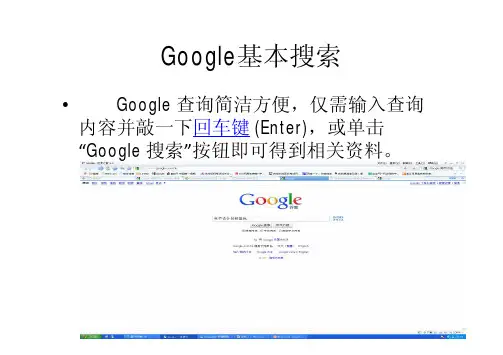
Google基本搜索•Google 查询简洁方便,仅需输入查询内容并敲一下回车键(Enter),或单击“Google 搜索”按钮即可得到相关资料。
搜索两个及两个以上关键字•Google 只会返回那些符合您的全部查询条件的网页。
不需要在关键词之间加上“and”或“+”。
如果您想缩小搜索范围,只需输入更多的关键词,只要在关键词中间留空格就行了。
搜索结果不包含某些特定信息•如果要避免搜索某个词语,可以在这个词前面加上一个减号(“-”,英文字符)。
但在减号之前必须留一空格。
自动简繁转换•Google有智能型汉字简繁自动转换系统。
值得注意的是这个系统不是简单的字符变换,还包括不同区域之间惯用语转换。
例如中国大陆称朝鲜为“北朝鲜”,而港台和海外则称之为“北韩”,因此在搜索简体的“北朝鲜”时,会同时自动对应搜索繁体的“北韩”。
当搜索所有中文网页时,Google会对搜索项进行简繁转换后,同时检索简体和繁体网页。
并将搜索结果的标题和摘要转换成和搜索项的同一文本,以便阅读。
拼音汉字转换•Google 运用智能软件系统对拼音关键词能进行自动中文转换并提供相应提示。
例如:搜索“yue guang”, Google 能自动提示“您是不是要找:月光”。
如果您点击“月光”,Google 将以“月光”作为关键词进行搜索。
对于拼音和中文混和关键词,系统也能做有效转换。
整词的搜索•在Google 中,可以通过添加双引号来搜索短语。
双引号中的词语(比如"月光博客")在查询到的文档中将作为一个整体出现,而不会自动进行分词处理。
这一方法在查找名言警句或专有名词时显得格外有用。
通配符•你可以在搜索时使用通配符“*”,这在搜索诗词时特别有效。
比如你可以搜一下“when i was young i'd listened to the radio * my favorite songs waiting ”可以通过模糊记忆的单词找到“yesterday once more”的歌词地址•Google良好的搜索和易用性已经得到了广大网友的欢迎,但是除了我们经常使用的Google网站、图像和新闻搜索之外,它还有很多其他搜索功能和搜索技巧。
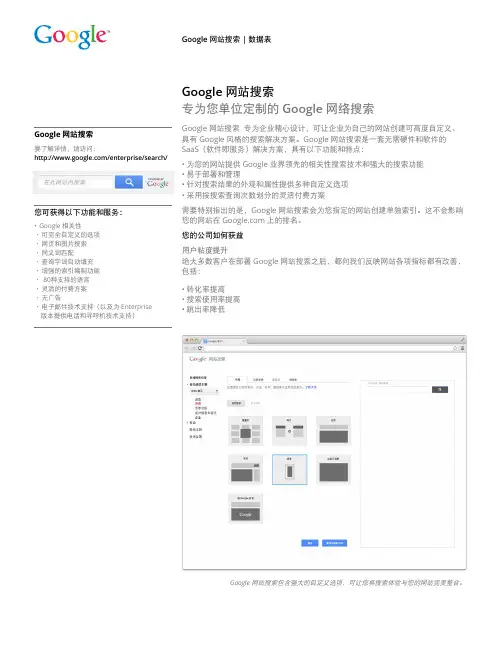
Google 网站搜索 | 数据表Google 网站搜索专为您单位定制的 Google 网络搜索Google 网站搜索 专为企业精心设计,可让企业为自己的网站创建可高度自定义、具有 Google 风格的搜索解决方案。
Google 网站搜索是一套无需硬件和软件的 SaaS (软件即服务)解决方案,具有以下功能和特点:• 为您的网站提供 Google 业界领先的相关性搜索技术和强大的搜索功能 • 易于部署和管理• 针对搜索结果的外观和属性提供多种自定义选项 • 采用按搜索查询次数划分的灵活付费方案需要特别指出的是,Google 网站搜索会为您指定的网站创建单独索引。
这不会影响您的网站在 上的排名。
您的公司如何获益用户粘度提升绝大多数客户在部署 Google 网站搜索之后,都向我们反映网站各项指标都有改善,包括:• 转化率提高 • 搜索使用率提高 • 跳出率降低Google网站搜索包含强大的自定义选项,可让您将搜索体验与您的网站完美整合。
Google 网站搜索要了解详情,请访问:/enterprise/search/您可获得以下功能和服务:• Google 相关性• 可完全自定义的选项• 网页和图片搜索• 同义词匹配• 查询字词自动填充• 增强的索引编制功能• 80种支持的语言• 灵活的付费方案• 无广告• 电子邮件技术支持(以及为 Enterprise版本提供电话和寻呼机技术支持)客户满意度提升客户普遍希望获得像 上一样的搜索体验,而 Google 网站搜索能够在客户使用的任意设备上提供这样的搜索体验。
易于管理Google 网站搜索的注册和管理通过在线控制台进行处理。
您提供想要 Google 网站搜索编入索引的网站后,这些网页将在数小时内被编入索引。
您还可以任意指定不同方式来对搜索体验进行自定义,无论是外观,还是搜索结果的提供方式和内容,都能自行设定。
其中很多功能都可由非技术人员操作,不过我们还提供了一些更高级的自定义选项。
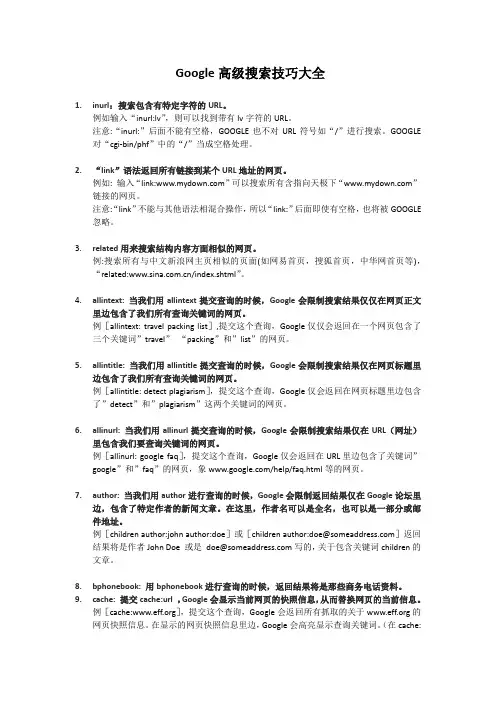
Google高级搜索技巧大全1.inurl:搜索包含有特定字符的URL。
例如输入“inurl:lv”,则可以找到带有lv字符的URL。
注意:“inurl:”后面不能有空格,GOOGLE也不对URL符号如“/”进行搜索。
GOOGLE 对“cgi-bin/phf”中的“/”当成空格处理。
2.“link”语法返回所有链接到某个URL地址的网页。
例如: 输入“link:”可以搜索所有含指向天极下“”链接的网页。
注意:“link”不能与其他语法相混合操作,所以“link:”后面即使有空格,也将被GOOGLE 忽略。
3.related用来搜索结构内容方面相似的网页。
例:搜索所有与中文新浪网主页相似的页面(如网易首页,搜狐首页,中华网首页等),“related:/index.shtml”。
4.allintext: 当我们用allintext提交查询的时候,Google会限制搜索结果仅仅在网页正文里边包含了我们所有查询关键词的网页。
例[allintext: travel packing list],提交这个查询,Google仅仅会返回在一个网页包含了三个关键词”travel”“packing”和”list”的网页。
5.allintitle: 当我们用allintitle提交查询的时候,Google会限制搜索结果仅在网页标题里边包含了我们所有查询关键词的网页。
例[allintitle: detect plagiarism],提交这个查询,Google仅会返回在网页标题里边包含了”detect”和”plagiarism”这两个关键词的网页。
6.allinurl: 当我们用allinurl提交查询的时候,Google会限制搜索结果仅在URL(网址)里包含我们要查询关键词的网页。
例[allinurl: google faq],提交这个查询,Google仅会返回在URL里边包含了关键词”google”和”faq”的网页,象/help/faq.html等的网页。
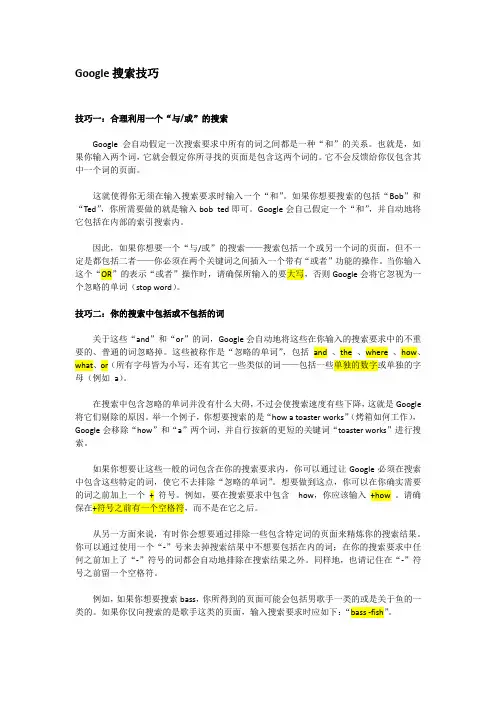
Google搜索技巧技巧一:合理利用一个“与/或”的搜索Google会自动假定一次搜索要求中所有的词之间都是一种“和”的关系。
也就是,如果你输入两个词,它就会假定你所寻找的页面是包含这两个词的。
它不会反馈给你仅包含其中一个词的页面。
这就使得你无须在输入搜索要求时输入一个“和”。
如果你想要搜索的包括“Bob”和“Ted”,你所需要做的就是输入bob ted即可。
Google会自己假定一个“和”,并自动地将它包括在内部的索引搜索内。
因此,如果你想要一个“与/或”的搜索——搜索包括一个或另一个词的页面,但不一定是都包括二者——你必须在两个关键词之间插入一个带有“或者”功能的操作。
当你输入这个“OR”的表示“或者”操作时,请确保所输入的要大写,否则Google会将它忽视为一个忽略的单词(stop word)。
技巧二:你的搜索中包括或不包括的词关于这些“and”和“or”的词,Google会自动地将这些在你输入的搜索要求中的不重要的、普通的词忽略掉。
这些被称作是“忽略的单词”,包括and、the、where、how、what、or(所有字母皆为小写,还有其它一些类似的词——包括一些单独的数字或单独的字母(例如a)。
在搜索中包含忽略的单词并没有什么大碍,不过会使搜索速度有些下降,这就是Google 将它们剔除的原因。
举一个例子,你想要搜索的是“how a toaster works”(烤箱如何工作),Google会移除“how”和“a”两个词,并自行按新的更短的关键词“toaster works”进行搜索。
如果你想要让这些一般的词包含在你的搜索要求内,你可以通过让Google必须在搜索中包含这些特定的词,使它不去排除“忽略的单词”。
想要做到这点,你可以在你确实需要的词之前加上一个+符号。
例如,要在搜索要求中包含how,你应该输入+how。
请确保在+符号之前有一个空格符,而不是在它之后。
从另一方面来说,有时你会想要通过排除一些包含特定词的页面来精炼你的搜索结果。
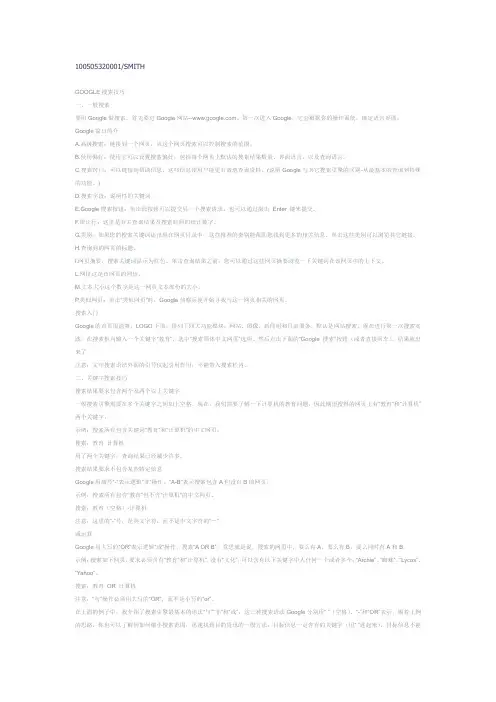
100505320001/SMITHGOOGLE搜索技巧一、一般搜索要用Google做搜索,首先要进Google网站。
第一次进入Google,它会根据你的操作系统,确定语言界面。
Google窗口简介A.高级搜索:链接到一个网页,从这个网页搜索可以控制搜索的范围。
B.使用偏好:使用它可以设置搜索偏好,包括每个网页上默认的搜索结果数量、界面语言,以及查询语言。
C.搜索窍门:可以链接到帮助信息,这些信息使用户能更有效地查询资料。
(说明Google与其它搜索引擎的区别-从最基本的查询到特殊的功能。
)D.搜索字段:说明性的关键词。
E.Google搜索按钮:单击此按钮可以提交另一个搜索请求。
也可以通过敲击Enter 键来提交。
F.统计行:这里是有关查询结果及搜索时间的统计数字。
G.类别:如果您的搜索关键词还出现在网页目录中,这些推荐的类别能帮助您找到更多的相关信息。
单击这些类别可以浏览其它链接。
H.查询到的网页的标题。
I.网页摘要,搜索关键词显示为红色。
单击查询结果之前,您可以通过这些网页摘要浏览一下关键词在该网页中的上下文。
L.网址这是该网页的网址。
M.文本大小这个数字是这一网页文本部份的大小。
P.类似网页:单击“类似网页”时,Google侦察兵便开始寻找与这一网页相关的网页。
搜索入门Google的首页很清爽,LOGO下面,排列了四大功能模块:网站、图像、新闻组和目录服务。
默认是网站搜索。
现在进行第一次搜索实践,在搜索框内输入一个关键字“教育”,选中“搜索简体中文网页”选项,然后点击下面的“Google搜索”按钮(或者直接回车),结果就出来了。
注意:文中搜索语法外面的引号仅起引用作用,不能带入搜索栏内。
二、关键字搜索技巧搜索结果要求包含两个及两个以上关键字一般搜索引擎需要在多个关键字之间加上空格。
现在,我们需要了解一下计算机的教育问题,因此期望搜得的网页上有“教育”和“计算机”两个关键字。
示例:搜索所有包含关键词“教育”和“计算机”的中文网页。
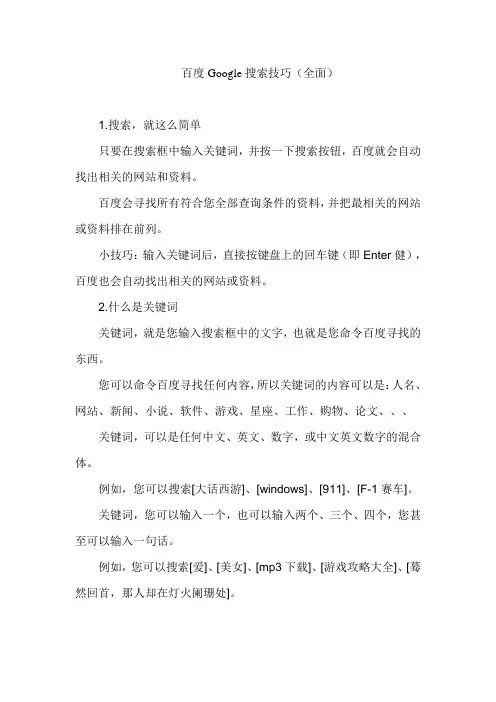
百度Google搜索技巧(全面)1.搜索,就这么简单只要在搜索框中输入关键词,并按一下搜索按钮,百度就会自动找出相关的网站和资料。
百度会寻找所有符合您全部查询条件的资料,并把最相关的网站或资料排在前列。
小技巧:输入关键词后,直接按键盘上的回车键(即Enter健),百度也会自动找出相关的网站或资料。
2.什么是关键词关键词,就是您输入搜索框中的文字,也就是您命令百度寻找的东西。
您可以命令百度寻找任何内容,所以关键词的内容可以是:人名、网站、新闻、小说、软件、游戏、星座、工作、购物、论文、、、关键词,可以是任何中文、英文、数字,或中文英文数字的混合体。
例如,您可以搜索[大话西游]、[windows]、[911]、[F-1赛车]。
关键词,您可以输入一个,也可以输入两个、三个、四个,您甚至可以输入一句话。
例如,您可以搜索[爱]、[美女]、[mp3下载]、[游戏攻略大全]、[蓦然回首,那人却在灯火阑珊处]。
提示:多个关键词之间必须留一个空格(按一下键盘上最长的那个键)。
3.准确的关键词百度搜索引擎严谨认真,要求"一字不差"。
例如:分别输入[舒淇]和[舒琪],搜索结果是不同的。
分别输入[电脑]和[计算机],搜索结果也是不同的。
因此,如果您对搜索结果不满意,建议检查输入文字有无错误,并换用不同的关键词搜索。
4.输入两个关键词搜索输入多个关键词搜索,可以获得更精确更丰富的搜索结果。
例如,搜索[北京暂住证],可以找到几万篇资料。
而搜索[北京暂住证],则只有严格含有"北京暂住证"连续5个字的网页才能被找出来,不但找到的资料只有几百篇,资料的准确性也比前者差得多。
因此,当你要查的关键词较为冗长时,建议将它拆成几个关键词来搜索,词与词之间用空格隔开。
多数情况下,输入两个关键词搜索,就已经有很好的搜索结果。
高级搜索功能1.减除无关资料有时候,排除含有某些词语的资料有利于缩小查询范围。
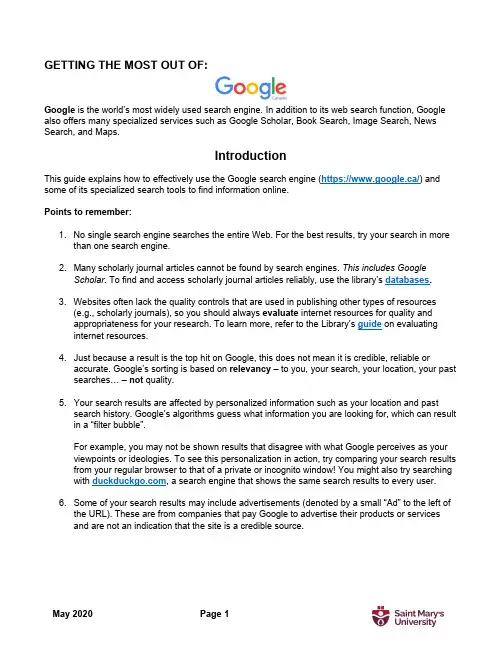
GETTING THE MOST OUT OF:Google is the world’s most widely used search engine. In addition to its web search function, Google also offers many specialized services such as Google Scholar, Book Search, Image Search, News Search, and Maps.IntroductionThis guide explains how to effectively use the Google search engine (https://www.google.ca/) and some of its specialized search tools to find information online.Points to remember:1.No single search engine searches the entire Web. For the best results, try your search in morethan one search engine.2.Many scholarly journal articles cannot be found by search engines. This includes GoogleScholar. To find and access scholarly journal articles reliably, use the library’s databases.3.Websites often lack the quality controls that are used in publishing other types of resources(e.g., scholarly journals), so you should always evaluate internet resources for quality andappropriateness for your research. To learn more, refer to the Library’s guide on evaluatinginternet resources.4.Just because a result is the top hit on Google, this does not mean it is credible, reliable oraccurate. Google’s sorting is based on relevancy – to you, your search, your location, your past searches… – not quality.5.Your search results are affected by personalized information such as your location and pastsearch history. Google’s algorithms guess what information you are looking for, which can result in a “filter bubble”.For example, you may not be shown results that disagree with what Google perceives as your viewpoints or ideologies. To see this personalization in action, try comparing your search results from your regular browser to that of a private or incognito window! You might also try searching with , a search engine that shows the same search results to every user.6.Some of your search results may include advertisements (denoted by a small “Ad” to the left ofthe URL). These are from companies that pay Google to advertise their products or servicesand are not an indication that the site is a credible source.Basic SearchGoogle search has some customizable features and will perform differently depending upon which settings are selected.Google has a built-in Autocomplete feature that is not possible to turn off. As you are typing your query, Google makes predictions about possible search terms for you. However, it is not necessary to choose any of the predictions.Google has an option to include Private results that can look for tailored content for you from other Google products you use, like Gmail or Google Calendar. This only works if you are signed into your Google account while searching, and it can be turned off by going into Settings and selecting Do not use private results .Searching with Google:To perform a search with Google, enter your keywords into the search box.When you have entered your keywords, either click on one of the Autocomplete predictions, hit Enter on your keyboard, or click on the search button on the browser.Search termsAutocomplete predictions Voice Search:To use Voice Search, click on the microphone icon in the search bar and follow the instructions. When choosing search terms:•Be specific and try to include at least 2 keywords that best describe what you are trying tofind. For example, to find apartments for rent in Halifax, you could search:•Avoid common words such as “how”, “of”, and “where” because these stop words will normallybe excluded from a search. If stop words occur in a common phrase or title such as Of Mice and Men , use quotation marks to search for the exact set of words:•Select appropriate terminology for your query and be aware that different terms may imply a certain bias:e.g., searching “oil sands” will retrieve results from Alberta Energy and other members ofthe oil industry, whereas a search for “tar sands” will retrieve results from Greenpeaceand other environmental advocacy organizations.•Word order can affect your search results. Words should be ordered in the way you would expect them to appear in a search result or how they appear in natural phrases:e.g., “world war” retrieves results about the First and Second World Wars, whereas “warworld” retrieves results about a DC comic book series.Writing a Search QueryWhen searching, it helps to understand how Google interprets what you enter:•Google searches for pages that contain as many of your terms as possible. However, it may return results without some of the terms you entered.o If a result is missing a search term, below its entry you will see: “Missing: term”•Google searches are not case sensitive.•Google automatically searches for variations of some search terms, e.g., “knit”, “knits”, “knitting”, etc. To prevent searching for variations of a term, enclose it in quotation marks.•You don’t need to type AND between your search terms.Basic Search OperatorsORe.g., canine OR dog OR puppy Finds pages that contain one or more of the search terms.–e.g., titanic –moviee.g., biology –site: Exclude particular words, phrases or sites from your results.Google’s version of the “NOT” operator.Can be combined with other special operators, such as site:“ ”e.g., “life of pi”Finds pages that contain the phrase exactly as typed between thequotation marks.*e.g., “* for an * makes thewhole world blind” Use the asterisk as a wildcard for unknown terms. Phrase search with quotations for variations of an exact phrase.Advanced SearchTo use advanced search, click on Settings in the bottom-right of the Google homepage and select Advanced Search from the pop-up menu.If you are in a search already, Settings will appear below the search bar. Or, visithttps://www.google.ca/advanced_search .First, type your search terms into the relevant search boxes:Then, refine your search by selecting one or more limit options, which are listed next to the searchboxes.Refining Your SearchIf your searches are retrieving too many irrelevant hits, use these special operators to increase the relevancy of your results:Special Search Operatorsintitle: Restrict your results to documents with a specified search term in the titlee.g., forensics intitle:universityallintitle: Restrict your results to documents with all of your search terms in the titlee.g., allintitle:google tutorialsite: Restrict your results to documents within a specified website or domaine.g., chemistry site:www.smu.cainurl: Restrict your results to documents with a specified search term in the URLe.g., book review inurl:librarydefine: Google tries to define the term first using dictionaries or encyclopaedias.e.g., define:deep webfiletype: Restrict your results to specific file types using file extensionse.g., syllabus filetype:docxe.g., thesis filetype:pdfrelated: Restrict your results to find webpages with similar content to a specific URLe.g., related:http://www.smu.ca/Note: do not place a space after the colon when using special operators.Google Search Results & Other Search ToolsYour searches could retrieve a variety of content, including links to books, news, images, etc. To limit your results to a particular format, e.g., images, simply select the Images tab located below the search bar on the results page. It is important to note that the placement of these links may change with every search. In the example below, Google Books results are hidden under the More tab, alongside Shopping, Flights, Finance, and Personal.Google Scholar does not appear in the tab below the search bar or in the “More” tab. Instead, Google may suggest “Scholarly articles for Your Search ”. This link will take you to Google Scholar .Google Books , Scholar , Images , News , and Maps also have their own dedicated sites and searchinterfaces. You can use the square “apps” button to access these products. The “apps” button appears at the top right hand side of many Google products, and displays a selection of “popular” apps by default. Image SearchNot to be confused with Google Photos, which is a tool for syncing, editing and sharing pictures.This feature allows you to search for images throughout the web. Enter keywords into the search box and if Google finds any matches to your query, it will display thumbnail pictures of the matches. Click on the thumbnails to view the full sized pictures.You can also upload an image, or paste an image’s URL, to search the web for images that are visually similar to that image. This can be useful for identifying the provenance or original source of an image.News On the Google News homepage, Google sorts its top news stories into various categories (e.g.,Canada, Health, etc.). Thousands of news sources, including traditional news sites, blogs, satire, and press releases are indexed by Google News . While many articles are free to access, some sources have paywalls and will limit the number of articles you are able to view without a subscription.Google News will also alter its contents based on your past searches and preferences. You may notice your favourite news websites appearing more frequently than ones you click on less often.Book SearchThis feature allows you to search the full-text of many books. Google has amassed a collection of scanned books through its affiliations with some prominent libraries, as well as through a partner program with publishers and authors who wish to have their books searchable by the public.Click on a book title and you will see basic bibliographic information about the book. If available, the full-text of the book will be viewable and available for download as a PDF. For some books you will onlybe able to “preview” some full-pages of titles. Other titles only offer “snippet” views of a few lines of text, showing full-text search results in context.If on campus, select the Find in a library (under Get thisbook in print) link and you will be directed to WorldCatLocal for SMU. Here you will be able to see if the item isavailable at the Patrick Power Library or through anotherNovanet library.Search within the full-text of the book for particular termsor phrases.MapsWith Google Maps, you can search for maps and directions to various locations (e.g., cities, streets, or restaurants). Browse streetscapes and explore landmarks as 360-degree images in Street View or try the Satellite view to see 3D imagery of the environment. Also try out Google’s related service, Google Earth, which offers features including a Maps Gallery, along with Sky, Moon, Ocean, and Mars viewing modes.Google ScholarGoogle Scholar is a specialized search engine developed for researchers and academics. Its index includes articles, books, patents, court opinions, scientific pre-prints, and government documents from many publishers and academic fields. With Google Scholar, you can search for scholarly literature on your topic – often in full-text – and then retrieve the items from the Patrick Power Library. See the Library’s Google Scholar Guide for more information.For more help…Don’t forget to check out the complete lists of online tutorials and library guides. You are always welcome to stop by the Research Help desk for further assistance with your assignments.Phone: (902) 420-5544Email: ***************。
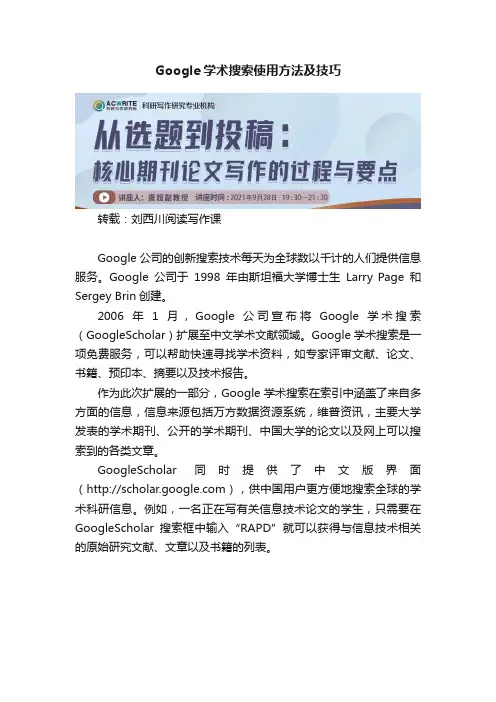
Google学术搜索使用方法及技巧转载:刘西川阅读写作课Google公司的创新搜索技术每天为全球数以千计的人们提供信息服务。
Google公司于1998年由斯坦福大学博士生Larry Page和Sergey Brin创建。
2006年1月,Google公司宣布将Google学术搜索(GoogleScholar)扩展至中文学术文献领域。
Google学术搜索是一项免费服务,可以帮助快速寻找学术资料,如专家评审文献、论文、书籍、预印本、摘要以及技术报告。
作为此次扩展的一部分,Google学术搜索在索引中涵盖了来自多方面的信息,信息来源包括万方数据资源系统,维普资讯,主要大学发表的学术期刊、公开的学术期刊、中国大学的论文以及网上可以搜索到的各类文章。
GoogleScholar同时提供了中文版界面(),供中国用户更方便地搜索全球的学术科研信息。
例如,一名正在写有关信息技术论文的学生,只需要在GoogleScholar搜索框中输入“RAPD”就可以获得与信息技术相关的原始研究文献、文章以及书籍的列表。
1Google学术搜索的优点Google学术搜索的主要优点包括如下几点:1相关性与Google网页搜索一样,Google学术搜索根据相关性对搜索结果进行排序,最相关的信息显示在页面上方。
这一排序同时考虑到每篇文章的全文内容、作者、发表该文章的刊物,以及该文章被其它学术著作引用的次数等要素。
2全文搜索在可能的情况下,Google会搜索全文,而不仅仅只是摘要部分,给予用户对学术内容最为全面深入的搜索,与此同时也加强了搜索结果的相关性。
3非在线文章搜索Google学术搜索涵盖了各方面的学术著作,包括还没有在线发布的学术研究结果。
比如爱因斯坦的很多著作并未在线发布,但却被众多学者引用。
Google学术搜索通过提供这些引用信息使搜索者了解到重要的未在线论文和书籍。
4多界面GoogleScholar同时提供了中文版界面供中国用户更方便地搜索全球的学术科研信息。
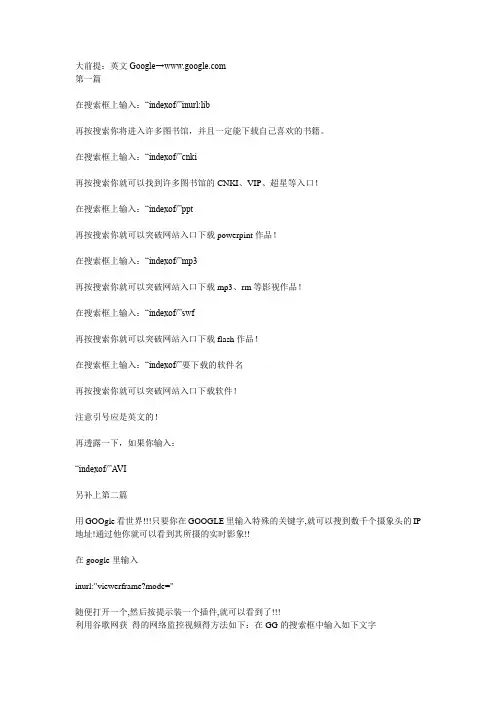
大前提:英文Google→第一篇在搜索框上输入:―indexof/‖inurl:lib再按搜索你将进入许多图书馆,并且一定能下载自己喜欢的书籍。
在搜索框上输入:―indexof/‖cnki再按搜索你就可以找到许多图书馆的CNKI、VIP、超星等入口!在搜索框上输入:―indexof/‖ppt再按搜索你就可以突破网站入口下载powerpint作品!在搜索框上输入:―indexof/‖mp3再按搜索你就可以突破网站入口下载mp3、rm等影视作品!在搜索框上输入:―indexof/‖swf再按搜索你就可以突破网站入口下载flash作品!在搜索框上输入:―indexof/‖要下载的软件名再按搜索你就可以突破网站入口下载软件!注意引号应是英文的!再透露一下,如果你输入:―indexof/‖A VI另补上第二篇用GOOgle看世界!!!只要你在GOOGLE里输入特殊的关键字,就可以搜到数千个摄象头的IP 地址!通过他你就可以看到其所摄的实时影象!!在google里输入inurl:"viewerframe?mode="随便打开一个,然后按提示装一个插件,就可以看到了!!!利用谷歌网获得的网络监控视频得方法如下:在GG的搜索框中输入如下文字inurl:‖axis-cgi/mjpg‖inurl:‖view /index.shtml‖inurl:‖ViewerFrame?Mode=‖image?cachebust=intitlE:‖Live View/-AXIS‖intext:‖MOBOTIX M1″intext:‖Open Menu‖inurl:‖ViewerFrame?Mode=‖inurl:‖MultiCameraFrame?Mode=‖就可以搜索到各种品牌的网络摄像头或监控器,如松下Panasonic和Camarades监控设备,通过viewerframe mode命令获得的网络视频,仅供大家闲暇娱乐,至于偷窥别人隐私视频的欲望,奉劝大家还是君子一点吧,毕竟这不是一个百无禁忌的社会。
Google从入门到精通速成手册一、Google是什么:在Yahoo!(雅虎)出现之前,即使互联网上的资料再多也没用,因为上网者没有一个系统的方法去搜索内容。
直至Yahoo!面世,世人才开始认识到搜索引擎(Search Engine)为何物,于是不断在网络内寻寻觅觅,发掘看不完的网页。
Yahoo!也顺理成章变为搜索引擎的同义词。
此后,Google的冒起改变了这种垄断局面。
Google每日二十四小时不间断地用数以千计的电脑在互联网自动“浏览”每个网页,并给他们逐个评分。
网民只要在Google 主页中输入关键字,Google就会从它到访过的网页中,找出评分最高的相关网页,在不到一秒时间内显示出来。
短短数年间,Google跃升为当今最受欢迎的搜索引擎,原因只有一个:它总是能找到大家想找的。
毫无疑问,Google改变了了互联网的新格局。
它以搜寻速度快和资料丰富的优点,迅速嬴得网民的欢心。
庞大的网站浏览量和人流,使Google的商业价值逐渐显现出来,摇身一变成为广告宣传、趋势分析,以及收集市场调查、统计数据的重要渠道和指标。
比如,Google 会定期发布全球电脑操作系统市场占有率的统计数字。
随着Google在网民心目中的地位日渐升高,Google已经成为广大网民间的流行俚语。
像“to Google someone”即表示在网上寻找一切跟某人有关的资料。
Google的影响力还不只成为网民的口头禅,它的搜寻结果更好比为一件事和物下了定义。
大家试着想像一下,你Google“本.拉登”,显示的结果尽是与“恐怖主义”和“恐怖袭击”有关,你能不相信他就是国际社会的大反派吗?(一)起源1995年,俄罗斯人Sergey Brin(图1)在美国斯坦福大学新一届博士生的聚会中,偶然遇到密歇根大学毕业的Larry Page(图2),两人都是电脑科学系(Computer Science)的毕业生。
当时他们不但没有一见如故,反而对每个话题都坚持自己的一套看法。
美国人教你这样用Google,你真的会变特工!!!(看了才感叹原来这么多年的GO OGLE是白用了~这就是百度永远无法超越G的原因吧~)来源:白一白的日志大前提:英文Google→第一篇在搜索框上输入:“indexof/”inurl:lib再按搜索你将进入许多图书馆,并且一定能下载自己喜欢的书籍。
在搜索框上输入:“indexof/”cnki再按搜索你就可以找到许多图书馆的CNKI、VIP、超星等入口!在搜索框上输入:“indexof/”ppt再按搜索你就可以突破网站入口下载powerpint作品!在搜索框上输入:“indexof/”mp3再按搜索你就可以突破网站入口下载mp3、rm等影视作品!在搜索框上输入:“indexof/”swf再按搜索你就可以突破网站入口下载flash作品!在搜索框上输入:“indexof/”要下载的软件名再按搜索你就可以突破网站入口下载软件!注意引号应是英文的!再透露一下,如果你输入:“indexof/”AVI另补上第二篇用GOOgle看世界!!!只要你在GOOGLE里输入特殊的关键字,就可以搜到数千个摄象头的IP地址!通过他你就可以看到其所摄的实时影象!!在google里输入inurl:"viewerframe?mode="随便打开一个,然后按提示装一个插件,就可以看到了!!!再补上第三篇三则黑客的Google搜索技巧简介大家都知道,Google毫无疑问是当今世界上最强大的搜索引擎。
然而,在黑客手中,它也是一个秘密武器,它能搜索到一些你意想不到的信息。
赛迪编者把他们进行了简单的总结不是希望您利用他去攻击别人的网站,而是利用这些技巧去在浩如烟海的网络信息中,来个大海捞针,寻找到对您有用的信息。
如果您是一名普通网民,您可以使用黑客的技巧扩大自己的视野,提高自己的检索效率;如果您是一名网管,请您赶快看看您的网站是否做好了对下面黑客探测手段的防范措施,如果没有就赶快来个亡羊补牢,毕竟隐患胜于明火,防范胜于救灾;如果您是一名黑客,相信您早以在别的黑客站点上见过类似的方法,这篇文章对您没什么用处,这里的技巧对您是小儿科,菜鸟级!您可以节省宝贵的时间做更有意义的事情,这篇文章您不用看了,到别处去吧!基于上面的考虑我编发了这篇文章。
可能我们用了很久Google都还不知道我们一直在被那个只有十多个链接的Google首页欺骗了,Google那个简单的输入框下还隐藏了多少秘密呢?让这100个Google搜索技巧提示你,或许它可以帮助你提高搜索效率。
来自实践家外贸论坛的google搜索的100种技巧1. 更加全面地用Google搜索的最好方式是点击高级搜索。
2. 它可以让你搜索更加精准的词组,“所有词组”或者是适当的搜索框里输入词组的某一个特定关键词。
3. 在高级搜索里你依然可以自定义在一张页面上展示多少个搜索结果,你所寻找的信息语言和文件格式。
4. “搜索以下网站或网域”可以让你通过输入一个顶级域名(如)来限定搜索结果。
5. 你也可以点击“日期、使用权限、数字范围和更多”的链接以获取更高级的功能。
(Google中文直接分条在页面展示。
)6. 保存设置,这些高级功能大多也可以在Google首页的搜索框中通过命令行参数来实现7. Google的主要搜索可以无形地用布尔结构“AND”来结合。
你当输入smoke fire - 它表示寻找smoke AND fire.8. 要让Google搜索Smoke 或者fire,只需要输入smoke OR fire.9. 你也可以用| 来代替OR。
如:smoke | fire.10. 像AND 和OR 这样的布尔结构对大小写非常敏感。
他们必须是全部大写。
11. 搜索专有名词,然后输入用括号括住的一个或者几个关键词。
比如water (smoke OR fire)12. 寻找短语,可以把它们放在引号里。
比如:”there’s no smoke without fire”。
13. 同义搜索来寻找那些类似的信息,只须在你的关键词臆加一根波浪线,比如:~eggplant.14. 用减号来排除关键词,如:new pram -ebay 可以让搜索结果排除来自Ebay的婴儿车信息。
15. 像I, and, then ,if 这类普通词语是要被Google 忽略的。
Google谷歌搜索引擎高级用法使用搜索语法精确搜索2010/08/22 00:50经常需要Google中搜索有关公司的相关新闻,但如果直接在搜索框中输入关键字,找到的网页有很多都是不相干的,因此只能将搜索结果一页一页翻下去,寻找有用的内容。
在一次搜索过程中无意查看了Google的搜索帮助,发现Google在搜索时,居然还可以使用多种搜索语法,用这些语法可以更快速的找到你所要的内容。
inurl:搜索包含有特定字符的URL。
例如输入“inurl:lv”,则可以找到带有lv字符的URL。
intitle:搜索网页标题中包含有特定字符的网页。
例如输入“intitle:谜盲世界”,这样就能找到网页标题中带有谜盲世界的网页。
site:限制搜索的域名范围。
例如输入“site:”,就可以只搜索域名为的网页。
filetype:搜索指定类型的文件。
例如你想下载PPT模板,那么只要输入“filetype:ppt”,就可以找到很多PPT模板文件。
搜索某个网站里的内容如“观赏鱼之家”里想找关于头洞病的文章。
直接在谷歌里打site: 头洞病link”语法返回所有链接到某个URL地址的网页。
示例:搜索所有含指向天极下载“”链接的网页。
搜索:“link:”结果:搜索有链接到的网页。
共约有695项查询结果,这是第1-10项。
搜索用时0.23秒。
注意:“link”不能与其他语法相混合操作,所以“link:”后面即使有空格,也将被GOOGLE忽略。
“inurl”语法返回的网页链接中包含第一个关键字,后面的关键字则出现在链接中或者网页文档中。
有很多网站把某一类具有相同属性的资源名称显示在目录名称或者网页名称中,比如“MP3”、“GALLARY”等,于是,就可以用INURL语法找到这些相关资源链接,然后,用第二个关键词确定是否有某项具体资料。
INURL语法和基本搜索语法的最大区别在于,前者通常能提供非常精确的专题资料。
示例:查找MIDI曲“沧海一声笑”。
一、Google谷歌搜索高级语法1. 减除无关资料(-)如果要避免搜索某个词语,可以在这个词前面加上一个减号(“-”,英文字符)。
但在减号之前必须留一个空格。
2. 英文短语搜索(””)在Google 中,可以通过添加英文双引号来搜索短语。
双引号中的词语(比如"like this")在查询到的文档中将作为一个整体出现。
这一方法在查找名言警句或专有名词时显得格外有用。
一些字符可以作为短语连接符。
Google 将“-”、“\”、“.”、“=”和“..."等标点符号识别为短语连接符。
3. 指定网域有一些词后面加上冒号对Google 有特殊的含义。
其中有一个词是“site:”。
要在某个特定的域或站点中进行搜索,可以在Google 搜索框中输入“site ”。
例如,要在Google 站点上查找新闻,可以输入:新闻site:4. 查找特定文件Google 已经可以支持13种非HTML文件的搜索——PDF文件,Microsoft Office (doc, ppt, xls, rtf)、Shockwave Flash (swf)、PostScript (ps)和其它类型文档。
新的文档类型只要与用户的搜索相关,就会自动显示在搜索结果中。
例如,如果您只想查找PDF或Flash 文件,而不要一般网页,只需搜索“关键词filetype:pdf”或“关键词filetype:swf”就可以了。
5. 按链接搜索例如,“link:”将找出所有指向Google 主页的网页。
不能将link: 搜索与普通关键词搜索结合使用。
6. 限定关键词只在标题中例如“allintitle:中国苹果”表示“中国”和“苹果”都必须出现在标题中“intitle:中国苹果”表示“中国”必须出现在标题中,“苹果”可以出现在网页的任意位置,可以是标题也可以不是。
7. 限定关键词只在URL中例如“allinURL:koko com”表示“koko”和“com”都必须出现在URL中“inURL:koko com”表示“koko”必须出现在URL中,“com”可以出现在网页的任意位置,可以是URL也可以不是。